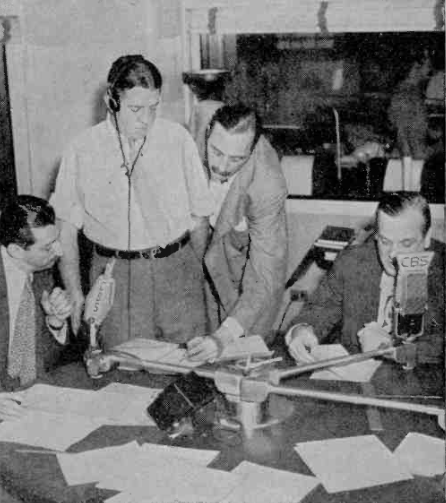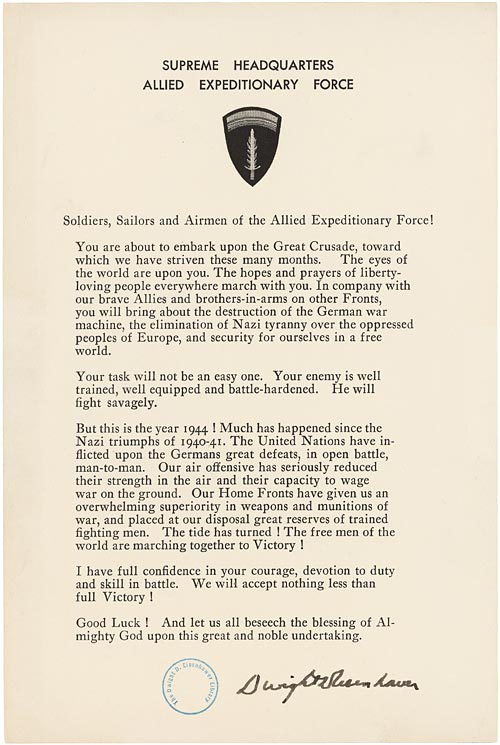The first report of D-Day comes from the Germans. At 6:33 a.m. London time, 43 minutes after the opening salvos of the pre-invasion naval bombardment, Berlin radio announces that the invasion has begun.
Four minutes later, at 12:37 a.m. Eastern War Time, an Associated Press bulletin hits the wire: LONDON TUESDAY JUNE 6 (AP) — THE GERMAN NEWS AGENCY TRANSOCEAN SAID TODAY IN A BROADCAST THAT THE ALLIED INVASION HAS BEGUN.
Four minutes after that, NBC breaks into a performance by the New York jazz trio The Three Suns with word of the German report, couched with consider-the-source disclaimers. Caution has been beaten into the heads of the American broadcast news operations for months, and reinforced less than 72 hours earlier after the AP’s false invasion flash.
At CBS’s New York studios, night news editor Jesse Zousmer phones CBS news chief Paul White immediately after the five bells chime on the AP teletype. White asks him to hold off on breaking into programming until there is some sort of confirmation. It comes minutes later when the International News Service teletype echoes the AP’s report. “Get it on the air,” White tells Zousmer.

Ned Calmer, who has been working at his desk since delivering the regular 11 p.m. news broadcast, walks into the newsroom moments later. Zousmer hands him a yellow scrap of paper and repeats White’s instructions. CBS breaks into its musical programming at 12:48 a.m. EWT with Calmer at the microphone:
We are interrupting this program to bring you a special bulletin. A bulletin has just been received from the London office of the Associated Press which quotes the German Trans-Ocean News Agency as asserting that the invasion of Western Europe has begun.
This report — and we stress it is of enemy origin with absolutely no confirmation from Allied sources — says that American landings were made this morning on the shores of northwestern France.
There is as yet no reason to believe that this report is anything more than a Germany propaganda move or a fishing expedition for information. You will recall that Prime Minister Churchill warned us not long ago that the actual invasion would be preceded by feints and diversions. Nevertheless, until confirmation or denial of this German report is forthcoming, the CBS World News staff is standing by and will bring you developments as reported.
None of the men who had just put those reports on the air could be sure it was the real thing, but the clock had begun ticking on a historic day in broadcast journalism.
Newsrooms in New York and London were now on full alert, and the intensity grew as scattered reports from official German media continued to arrive. Finally, nearly three hours after the initial bulletin, Supreme Headquarters, Allied Expeditionary Force, released Communique No. 1.
At 9:30 a.m. in London, 3:30 a.m. in New York, broadcasters were given a two-minute warning for the release. Robert Trout was at the microphone for CBS, Robert St. John for NBC, and John Snagge for the BBC. The two American networks took the announcement direct from Col. R. Ernest Dupuy, the SHAEF public relations chief, at 3:32 a.m.. Snagge read the communique over the air to the BBC audience:
Minutes after Dupuy’s announcement, CBS switched back to London and its flagship voice, Edward R. Murrow, who read the text of Gen. Dwight D. Eisenhower’s “order of the day.” The mission statement for the operation had been printed by the thousands and distributed to American, British and Canadian troops set to arrive by air and sea alike.

The Supreme Allied Commander also had prerecorded himself reading the order, along with additional messages to the citizens of occupied Europe. Those were broadcast across the various networks as the day unfolded.
At about 3:43 a.m., U.S. audiences heard the first account from a correspondent on the scene. The pool report from Herbert M. Clark of the Blue Network had been sent in advance, to be released only after Communique No. 1 went public. Clark was aboard the HMS Hilary, the flagship for naval forces off Juno Beach. He spoke from an unnamed British harbor, describing the scene as the invasion armada got underway:
I can see twenty-three square miles of invasion boats from where I stand on the deck. … If you double that figure you will approximate the size of the invasion fleet now bearing down on the enemy coastline.
Clark’s report provided a taste of what the men on the front lines were seeing, but it would be about 30 more minutes before listeners heard from someone reporting on the day’s action. It came at 4:17 a.m. in a pooled broadcast from Wright Bryan, accredited to the Atlanta Journal and the NBC affiliate WSB.
The 6-foot-5 correspondent had squeezed into a C-47 called “Snooty” overnight and tagged along as 17 U.S. paratroopers from the 101st Airborne leapt into Normandy. Bryan spoke for 15 minutes, beginning with a brief sketch of the scene before backing up to tell the full story of the two days he had spent with Maj. Clement G. Richardson and the 89th Troop Carrier Squadron at RAF Greenham Common.

Lt. John E. Peters of Chicago was at the controls of “Snooty” as it taxied out around 10 p.m. for the unit’s first combat mission. Bryan shuttled between the flight deck and the navigator’s dome, recording observations and snippets of conversation in his notebook, then headed to the back of the plane.
Down the long passenger cabin I walked to see how the paratroopers were riding. More than half of them had taken their colonel’s advice and were dozing with their heads back against the wall and their feet stretched out in front of them. The others were sitting silently except for two or three who talked among themselves in whispers. By the open rear door, Col. Cole waited, and said, “It’s cold back here with the wind whipping in.”
I had been perspiring in the crew cabins up front, but back where the colonel sat I was glad I wore heavy clothing.
When it came time for the passengers to depart, Bryan watched in amazement as the entire stick shot out the open door in what he estimated to be 10 or 12 seconds. Well, all but one of them. One man toward the end of the line hit the doorframe and tumbled to the cabin floor in a daze. The men behind him moved right by and jumped out the door.
Before the unhappy soldier could get to his feet, our plane was well past the drop zone, and in a matter of minutes it was back over the water and setting a course for home. It was too late, and that soldier had to return with us. He was inconsolable. He thought his comrades might think him yellow. The plane crew assured him they would think no such thing, but he sat moody and glum all the way back.
By Bryan’s count, “Snooty” was over France for only 11 minutes, but the men aboard had done their job. His report concluded: “The battle of Europe had begun and our squadron had delivered the first Allied foot soldiers to their scene of action.”
True eyewitness reports that added depth and detail to Bryan’s initial offering would continue to flow in throughout June 6 and across the days that followed.
Some came from correspondents who, like Bryan, had flown over the invasion beaches and hustled back to London to report on what they had seen. Others collected sound on the spot, using wire and film recorders to capture the actual sounds of the front lines. George Hicks’ legendary broadcast from the USS Ancon as D-Day turned to D plus 1 was made with a film recorder.
Use of recorded reports from correspondents broke a longstanding precedent for American news networks. Though the BBC had sent reporters into the field with portable recording units for some time before D-Day, U.S. networks had resisted. The rapid-fire nature and challenging logistics of covering such a wide-ranging operation caused them to rethink that stance.
Despite the appealing immediacy of reports from the field, both U.S. and U.K. broadcast outlets would continue to lean on the newsreaders behind the microphones in studio settings to anchor their coverage.
Snagge was one of the best, and his BBC midday report on June 6 did as fine a job as any of summing up what we knew about the long-anticipated invasion right up to that moment in time. He began: “D-Day has come.”
COVERING D-DAY Check out these behind-the-scenes stories you might have missed: D-Day: Keeping the Mulberry secret Ernie Pyle's struggle to tell the invasion story Martha Gellhorn goes rogue to get her D-Day story Radio breaks the invasion news to the world Parachuting behind enemy lines ... with a typewriter Correspondents missing D-Day feel left out Joan Ellis and the AP's accidental invasion flash D-Day with Ike: Red Mueller at Eisenhower's HQ D-Day correspondents balance fear, ambition Hemingway invades London ahead of D-Day Bringing the sound of battle into your living room Hitting Utah Beach with Ken Crawford




Leave a comment